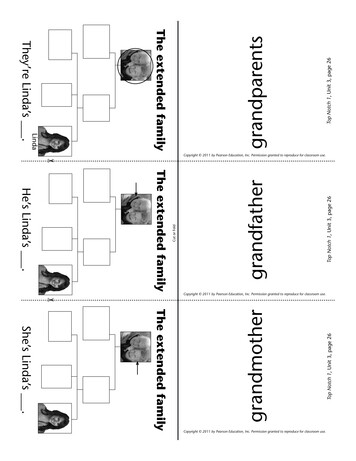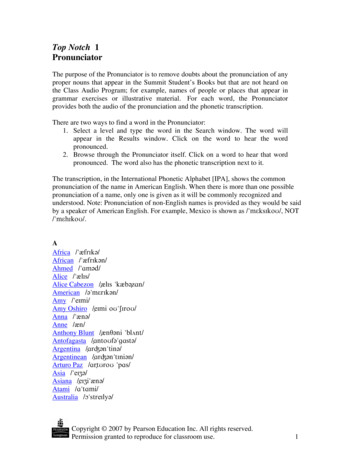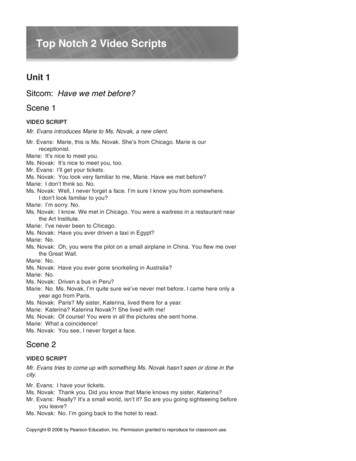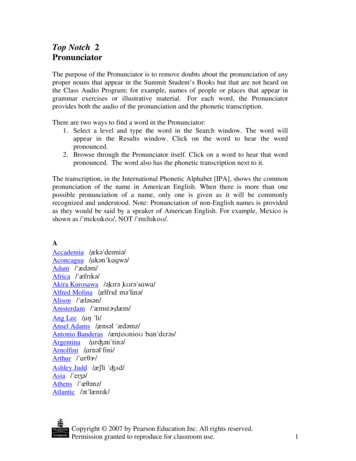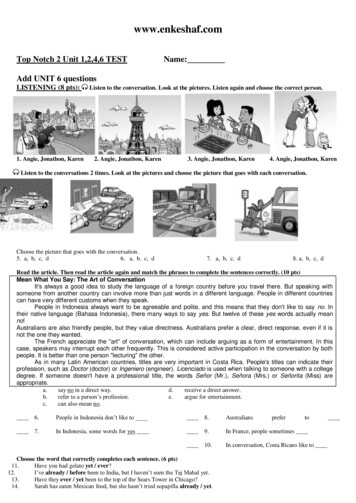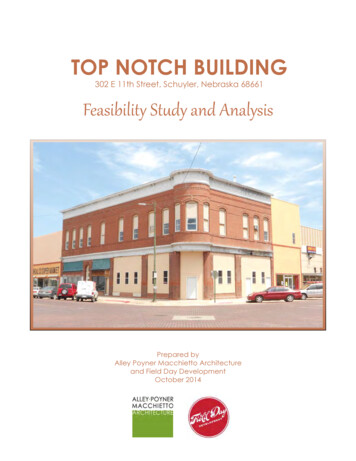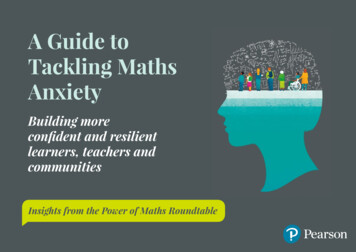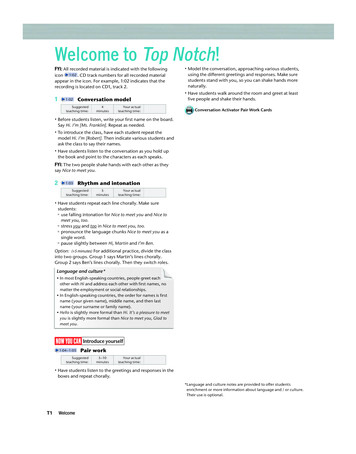
Transcription
Welcome to Top Notch!FYI: All recorded material is indicated with the following Model the conversation, approaching various students,using the different greetings and responses. Make surestudents stand with you, so you can shake hands morenaturally. Have students walk around the room and greet at leastfive people and shake their hands.icon 1:02 . CD track numbers for all recorded materialappear in the icon. For example, 1:02 indicates that therecording is located on CD1, track 2.11:02Conversation modelSuggestedteaching time:4minutesYour actualteaching time: Before students listen, write your first name on the board.Say Hi. I’m [Ms. Franklin]. Repeat as needed. To introduce the class, have each student repeat themodel Hi. I’m [Robert]. Then indicate various students andask the class to say their names. Have students listen to the conversation as you hold upthe book and point to the characters as each speaks.Conversation Activator Pair Work CardsFYI: The two people shake hands with each other as theysay Nice to meet you.21:03Rhythm and intonationSuggestedteaching time: 5minutesYour actualteaching time:Have students repeat each line chorally. Make surestudents:use falling intonation for Nice to meet you and Nice tomeet you, too.stress you and too in Nice to meet you, too.pronounce the language chunks Nice to meet you as asingle word.pause slightly between Hi, Martin and I’m Ben.Option: ( 5 minutes) For additional practice, divide the classinto two groups. Group 1 says Martin’s lines chorally.Group 2 says Ben’s lines chorally. Then they switch roles.Language and culture* In most English-speaking countries, people greet eachother with Hi and address each other with first names, nomatter the employment or social relationships. In English-speaking countries, the order for names is firstname (your given name), middle name, and then lastname (your surname or family name). Hello is slightly more formal than Hi. It’s a pleasure to meetyou is slightly more formal than Nice to meet you, Glad tomeet you.now you can Introduce yourself1:04 –1:05Pair workSuggestedteaching time: 5–10minutesYour actualteaching time:Have students listen to the greetings and responses in theboxes and repeat chorally.*Language and culture notes are provided to offer studentsenrichment or more information about language and / or culture.Their use is optional.T1WelcomeM01 TOPN TE FND 0523 U01.indd T110/29/14 11:56 AM
communication goalsWelcome to Top Notch!goal1Introduce yourself1:022CONVERSATION MODEL ReaRead and listen.A: Hi. I’m Martin.B: Hi, Martin. I’m Ben.21 Introduce yourself.2 Greet people.3 Say good-bye.A: Nice to meet you, Ben.B: Nice to meet you, too.RHYTHM AND INTONATION Listen again and repeat. Then practice the ConversationModel with a partner.1:03now you canIntroduce yourselfPAIR WORK Now introduce yourself to your classmates.1:04GreetingsingsHi.Hello.I’m [Lisa].ResponsesRNice to mmeet you.Glad to mmeet you.It’s a pleapleasure to meet you.1:05WelcomeM01 TOPN TE FND 0523 U01.indd 1110/29/14 11:56 AM
goal1Greet people1:06CONVERSATION MODEL Read and listen.A: Hi, Len. How are you?B: Fine, thanks. And you?A: I’m fine.21:07 RHYTHM AND INTONATION Listen again andrepeat. Then practice the Conversation Modelwith a partner.31:08 VOCABULARY More greetings Read andlisten. Then listen again and repeat.1 Good morning.2 Good afternoon.3 Good evening.now you canGreet peoplePAIR WORK Now greet your classmates.GreetingsHow are you?How’s everything?How’s it going?1:09ResponsesFine. / I’m fine.Great.1:10ſKNot bad.So-so.Welcome2 2WelcomeM01 TOPN TE FND 0523 U01.indd 210/29/14 11:56 AM
11:06Conversation modelSuggestedteaching time:3minutes FYI: Len sounds like Ben.Have students read and listen. Have students listen asoften as necessary. 21:07Rhythm and intonationSuggestedteaching time:5minutesYour actualteaching time:Option: ( 5 minutes) Divide the class into two groups.Group 1 chorally repeats A’s lines. Group 2 chorally repeatsB’s line. Then students switch roles.Language and culture In the U.S., people usually say How are you? to sayHello. It is not expected that you describe or give detailsabout how you are feeling. I’m fine is sufficient. Ifsomeone wants to continue the conversation or wants tohear more personal information about you, he or she mayadd So, how is everything? or How are things going? Shaking hands is considered the accepted greeting ininternational business situations. It is also a commongreeting in social situations. In general, when shakinghands in English-speaking countries, look at the person’seyes and smile. Shake hands briefly, but firmly.31:08VocabularySuggestedteaching time: 5minutesYour actualteaching time:Make sure that students understand the abbreviations inthe pictures:a.m. in the morningp.m. in the afternoon or in the eveningIf your students are not familiar with telling time this way,you may want to convert the times to 24-hour style toclarify. Write on the board:8:00 A. M. 08002:00 P. M. 14006:00 P. M. 1800 Have students listen and study the greetings and the timeof day each greeting can be used. Then have students repeat each greeting chorally.Say each time and have students say the appropriategreeting. (Good afternoon, Good evening, Goodmorning.)Option: ( 5 minutes) For additional practice, have studentswork in pairs. Student A writes three times on a piece ofpaper. Student B says the matching greeting for each.Language and culture Times can be said in different ways in English. 6:00 p.m.m.can be said six o’clock, six p.m., six, six in the evening. a.m.means before noon. p.m. indicates time between noon andmidnight. Good evening is a greeting and means Hello. Good nightmeans Good-bye. At the end of a workday, many people inNorth America will say Good night even if it is only 5:00 inthe afternoon.Have students repeat each line chorally. Make surestudents:use falling intonation for How are you?stress are in How are you?use rising intonation for And you?stress fine and you in Fine, thanks. And you? Write on the board:It ’s 3:00 P. M.It ’s 7:00 P. M.It ’s 9:00 A. M.Your actualteaching time:Point to the man in the photo and say This is Len. now you can Greet people1:09 –1:10Pair workSuggestedteaching time:5–10minutesYour actualteaching time: Have students listen to the greetings and responses in theboxes. Then have students repeat chorally. Model the conversation. Approach various students anduse the different greetings and responses. For example:T: How’s everything?S: Not bad. And you?T: Fine, thanks. Have students walk around the room and say hello to fivedifferent people. Encourage students to try to use all of the greetings andresponses presented in this unit. Encourage students to pay attention to their rhythm andintonation. Ask various pairs to role-play one of their conversations infront of the class.Language and culture How’s everything? and How’s it going? are moreinformal than How are you? The customary response to How are you? is Fine. If youare not doing well, you can say Not bad or So-so. Manypeople, however, always say fine no matter how badthey feel.Conversation Activator Pair Work CardsWelcomeM01 TOPN TE FND 0523 U01.indd T2T210/29/14 11:56 AM
11:11Conversation modelSuggestedteaching time:3minutesYour actualteaching time: Before students listen, model waving with your hand andsaying good-bye. The palm of the hand faces out and thehand moves side to side. In the photos, people’s handsare at chest and shoulder height because they are closeto each other. If you were far away from a person, youwould probably wave your hand higher up in the air. Youmay want to ask students to wave to a classmate. Have students read and listen to the conversation. Havestudents listen as often as necessary.21:12Rhythm and intonationSuggestedteaching time: 5minutesYour actualteaching time:Have students repeat each line chorally. Make surestudents:use falling intonation for all of the sentences.stress -bye in Good-bye.stress -mor- in tomorrow.stress the o in OK and see in See you!Option: Oral Progress AssessmentThe following can be used as a review of the material inthe Welcome Unit. It is designed for use with the wholeclass. Introduce yourself to several students. For example:T: Hello. I’m [Mr. Rogers].S. Hi, I’m [Natalie].T: It’s a pleasure to meet you.S: Nice to meet you, too. Greet several students. For example:T: Hi, [Paul]. How are you?S: I’m fine. And you?T: I’m great. Say good-bye to several students. Use differentforms. Encourage students to answer with differentresponses. For example:T: Good-bye [Name].S: See you later.Evaluate students on intelligibility, fluency, correct useof target grammar, and appropriate use of vocabulary.Oral Progress Assessment ChartsOption: ( 5 minutes) Extend the activity by dividing the classinto two groups. Have the groups stand up and face eachother. Group 1 repeats Emily’s lines in the conversation.Group 2 repeats Charlotte’s lines. Encourage students towave good-bye. Then have students switch roles.now you can Say good-bye1:13Pair workSuggestedteaching time:5–10minutesYour actualteaching time: Have students listen to the ways to say good-bye in thebox. Then have students repeat chorally. Ask students to walk around the room and say good-byeto five different people. Have them use the gesture ofwaving as they walk away. Encourage students to pay attention to rhythm andintonation as they talk.Conversation Activator Pair Work CardsT3WelcomeM01 TOPN TE FND 0523 U01.indd T310/29/14 11:56 AM
goal11:11A:B:A:B:2Say good-byeCONVERSATION MODEL Read and listen.Good-bye, Charlotte.Good-bye, Emily.See you tomorrow.OK. See you!1:12 RHYTHM AND INTONATION Listen againand repeat. Then practice the ConversationModel with a partner.now you canSay good-byePAIR WORK Now say good-bye to your classmates.1:13 Ways to say good-byeGood-bye.Bye.See you later.Take care.now i canIntroduce myself.Greet people.Say good-bye.WelcomeWelcome3M01 TOPN TE FND 0523 U01.indd 3310/29/14 11:56 AM
communication goalsLESSONUNITDIGITALFLASHCARDSgoal1111 Tell a classmate your occupation.2 Identify your classmates.3 Spell names.Names and OccupationsTell a classmate your occupationVOCABULARY BOOSTER1:14More occupations p. 125VOCABULARY Occupations Read and listen. Then listen again and repeat.1 a teacher2 a student3 an architect6 a musician4 an actor5 an athlete7 an artist9 a singer2PAIR WORK Say the name of an occupation. Your partner points (3GRAMMAR Verb be: singular statements / Contractions10 a flight attendantF48 a banker) to the picture.Articles a / ana teacheran actorAffirmative statements / ContractionsI am Ann. / I’m Ann.Negative statements / ContractionsI am not Jen. / I’m not Jen.You are an architect. / You’re an architect.You are not an artist. / You’re not an artist. / You aren’t an artist.He is a teacher. / He’s a teacher.She is a singer. / She’s a singer.He is not a student. / He’s not a student. / He isn’t a student.She is not a banker. / She’s not a banker. / She isn’t a banker.UNIT 1M01 TOPN TE FND 0523 U01.indd 410/29/14 11:56 AM
LESSONUNIT11Names and Occupations11:14VocabularySuggestedteaching time:4–5minutesYour actualteaching time: Invite volunteers to the board to write the contractionsfor you are, he is, and she is. (you’re, he’s, she’s.) Have students repeat the contractions chorally. Make apulling gesture with your hands to indicate the length ofthe vowel in he’s and she’s. Direct attention to the negative statements and havestudents study the examples. Write on the board I am a singer. Point to yourself andsay I am not a singer. Write the word not after am on theboard: I am not a singer. Show students that not is placed after the verb be. Call attention to the two negative contracted forms. Havestudents repeat them chorally. Direct attention to the box on the right with articles. Write on the board:Vocabulary Flash Card Player First listening: Have students study the words as theylisten.Second listening: Have students repeat the wordschorally.Option: VOCABULARY BOOSTER ( 5–10 minutes)vowels: a, e, i, o, uconsonants: b, d, f, g, h, j, k, l, m, . . . (etc.)Language and culture From the Longman Corpus: It is becoming increasinglyglycommon, in both spoken and written English, to use actorrather than actress to refer to females. However, actress isused about three times more often for girls and women. Direct students’ attention to the way that a and an arepresented in Exercise 1. Ask them to say the occupationsthat begin with vowel sounds in Exercise 1. (architect,actor, athlete, artist) Say the rule Use an before a vowel. Ask students to say the occupations beginning withconsonant sounds. (teacher, student, musician, banker,singer, flight attendant) Say the rule Use a before aconsonant. You may want to write the two rules on the board.2 Pair workSuggestedteaching time:4–5minutesYour actualteaching time: Model the activity. Say the name of an occupation andhave all students point to the corresponding photo. Movearound the room to check their responses. If some pairs finish the activity quickly, have them reversethe activity. Student A covers the words and points to apicture, and Student B says the occupation.Language and culture3 GrammarSuggestedteaching time:10–15minutesYour actualteaching time: Direct attention to the affirmative statements and havestudents study the examples. Say I am a teacher. Indicate a student and say You are astudent. Point to photo 5 in Exercise 1 and say He is anathlete. Point to photo 8 and say She is a banker. Write the following on the board and have studentsrepeat each one chorally:I amyou areOption: ( 5 minutes) For additional practice, write on theboard I am a teacher. He is a singer. She is an actor.Ask students to make contractions. (I’m, He’s, She’s) Thenhave them make all possible negative forms. (I am not / I’mnot, He is not / He’s not/ He isn’t, She is not / She’s not /She isn’t)he is The rule for a / an is based on sound, not on spelling
Welcome 1 Welcome to Top Notch! now you can Introduce yourself PAIR WORK Now introduce yourself to your classmates. 1:04 Greetings Hi. Hello. I’m [Lisa]. 1 1:02 CONVERSATION MODEL Read and listen. A: Hi.I’m Martin. B: Hi, Martin. I’m Ben. A: Nice to meet you, Ben. B: Nice to meet you, too. 2 1:03 RHYTHM AND INTONATION Listen again and repeat. Then practice the Conversation
